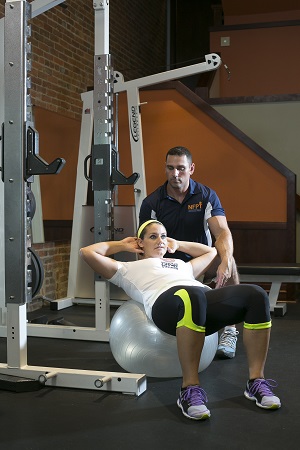What is a Stability Ball Crunch?
The stability ball crunch is an abdominal exercise which predominantly targets the abdominal muscles. It’s a progression from doing crunches on the floor, on a mat because additional core strength and stability is required to balance on the ball. Use this exercise after a baseline of strength in the core has been achieved.
Target Muscle Group
Rectus abdominus (the long sheath of muscle running vertically down the trunk) usually gets pinned as the prime mover for this exercise. The stability ball crunch is considered an abdominal exercise. Many abdominal or core exercises involve more muscles than those that are predominantly viewed as the “target” or “prime mover”. And it can vary from different professional references and textbooks.
In other words, there are more muscles involved than just the rectus. Probably internal and external oblique and some hip flexor muscles as well.
Benefits of Stability Ball Crunch
Any “core” exercise is performed to improve the strength and endurance of the abdominal muscles. The abdominal muscles are postural muscles and are generally fatigue resistant. Improving the stamina and strength of the abdominal muscles (and this rule applies to all muscle groups) improves activities of daily living (ADLs), improves posture, enhances balance and stability, and improves overall physical function and endurance.
Instructions for Proper Stability Ball Crunch

Starting Position
1. Sit on the ball with feet flat on the floor and hip width apart such that the knees and hips are at a 90-degree angle.
2. Roll down on the ball so that the mid to low back is in contact with the ball and the torso is parallel to the floor.
3. Place the hands near the sides of the head or cross the arms across the chest.
Upward Phase
1. Slightly flex the neck to bring the chin nearer to the chest (do not hyper-flex the neck) and curl the torso so that the upper back is off the ball.
2. Make sure to maintain the lower body position established in the starting phase of the movement. Keep the arms stationary in their position across the chest or near the sides of the head as the movement is completed.
Downward Phase
1. Uncurl the torso and return to starting position in a slow and controlled manner. Do not use momentum to perform the next repetition.
2. Repeat for a specified number of repetitions (this will vary based on training goal and client abilities).
Notes: It’s imperative to make sure you use the appropriate size stability ball and that it is inflated properly.
Common Errors
• Incomplete range of motion
• Improper hand placement
• Sitting too low or too far back on the ball
• Using a ball that is too small or too large
• Pulling on the neck
• Using momentum
Variations of the Exercise
Abdominal exercises can be performed in a variety of ways including the following.
• Bent-knee crunches
• BOSU ball crunches
• Bicycles
• Planks and variations
• Stability ball pike
• Stability ball jackknife
Exercise variety is the spice of fitness programming. It’s fun to have many exercise options to go to as a personal trainer. It’s also important to be mindful of what muscles you’re trying to work (and not work) so you can cue proper form and prevent injuries.
[info type=”facebook]”What’s your favorite way to crunch? If you’re an NFPT trainer, join the Facebook Community Group to chat with other trainers. If you’re not, come talk with NFPT here, we would like to meet you![/info]
Dr. Erin Nitschke, NFPT-CPT, NSCA-CPT, ACE Health Coach, Fitness Nutrition Specialist, Therapeutic Exercise Specialist, and Pn1 is a health and human performance college professor, fitness blogger, mother, and passionate fitness professional. She has over 15 years of experience in the fitness industry and college instruction. Erin believes in the power of a holistic approach to healthy living. She loves encouraging her clients and students to develop body harmony by teaching focused skill development and lifestyle balance. Erin is also the Director of Educational Partnerships & Programs for the NFPT. Erin is an editorial author for ACE, IDEA, The Sheridan Press, and the Casper Star Tribune. Visit her personal blog at belivestaywell.com

